Track
Anthropic just made their biggest announcement in a while with the release of Claude 3.7 Sonnet. Despite what the version number suggesting only incremental progress, we think this is a significant upgrade over Claude 3.5 Sonnet.
First off, Claude 3.7 Sonnet introduces Thinking Mode, which lets us see the model’s thought process. This means Anthropic is finally entering the reasoning models arena, and based on the benchmarks, it’s a worthy competitor to OpenAI’s o3-mini, DeepSeek-R1, and Grok 3.
Second, Claude 3.7 Sonnet can switch between reasoning mode and generalist mode with the touch of a button (more on this in a bit). While Anthropic claimed they have “a different philosophy,” this shift reflects a growing trend in unifying the user experience across chat-based LLMs. Grok 3 already works this way, and Sam Altman recently announced that ChatGPT will follow a similar direction.
What we find disappointing is that Thinking Mode is locked behind a paywall. Given that reasoning models are becoming more common, it’s hard to justify this decision when you can already access free, albeit sometimes limited, versions through Grok, DeepSeek, Qwen, and even ChatGPT.
Let’s go over the essentials of Claude 3.7 Sonnet—and make sure to check out our video coverage of Claude 3.7 Sonnet as well:
What Is Claude 3.7 Sonnet?
Claude 3.7 Sonnet is Anthropic’s latest AI model, positioned as a major step forward in reasoning, coding, and real-world problem-solving. The biggest change is that Claude 3.7 Sonnet now supports Thinking Mode, allowing us to see the model’s step-by-step reasoning process. Let’s see how this works:
Reasoning models are becoming more important and common, and we can see why. If you look at the graph below, you’ll notice that 37.2% of users rely on Claude for coding and math questions, according to the Anthropic Economic Index. That tells us one thing—strong reasoning models can bring real business value, especially as AI adoption in enterprise settings remains low.
Source: Antrophic Economic Index
At the same time, Claude 3.7 isn’t just a reasoning model—it’s a hybrid. We can switch between Thinking Mode (for structured reasoning tasks) and a standard chat mode for general conversation, writing, and summarization.
Claude 3.7 Sonnet vs. Claude 3.5 Sonnet
Claude 3.7 Sonnet is a much bigger upgrade than the version number suggests. The benchmark data confirms that it outperforms Claude 3.5 Sonnet in reasoning, coding, and real-world task execution.
Software engineering performance
Claude 3.7 Sonnet shows a clear advantage in software engineering, with a 62.3% accuracy score in SWE-bench Verified, a significant jump from Claude 3.5 Sonnet’s 49.0%. When using a custom scaffold (a structured prompt or additional context that helps guide the model’s response toward a more accurate solution), that accuracy increases to 70.3%, making it the best-performing model in this category.
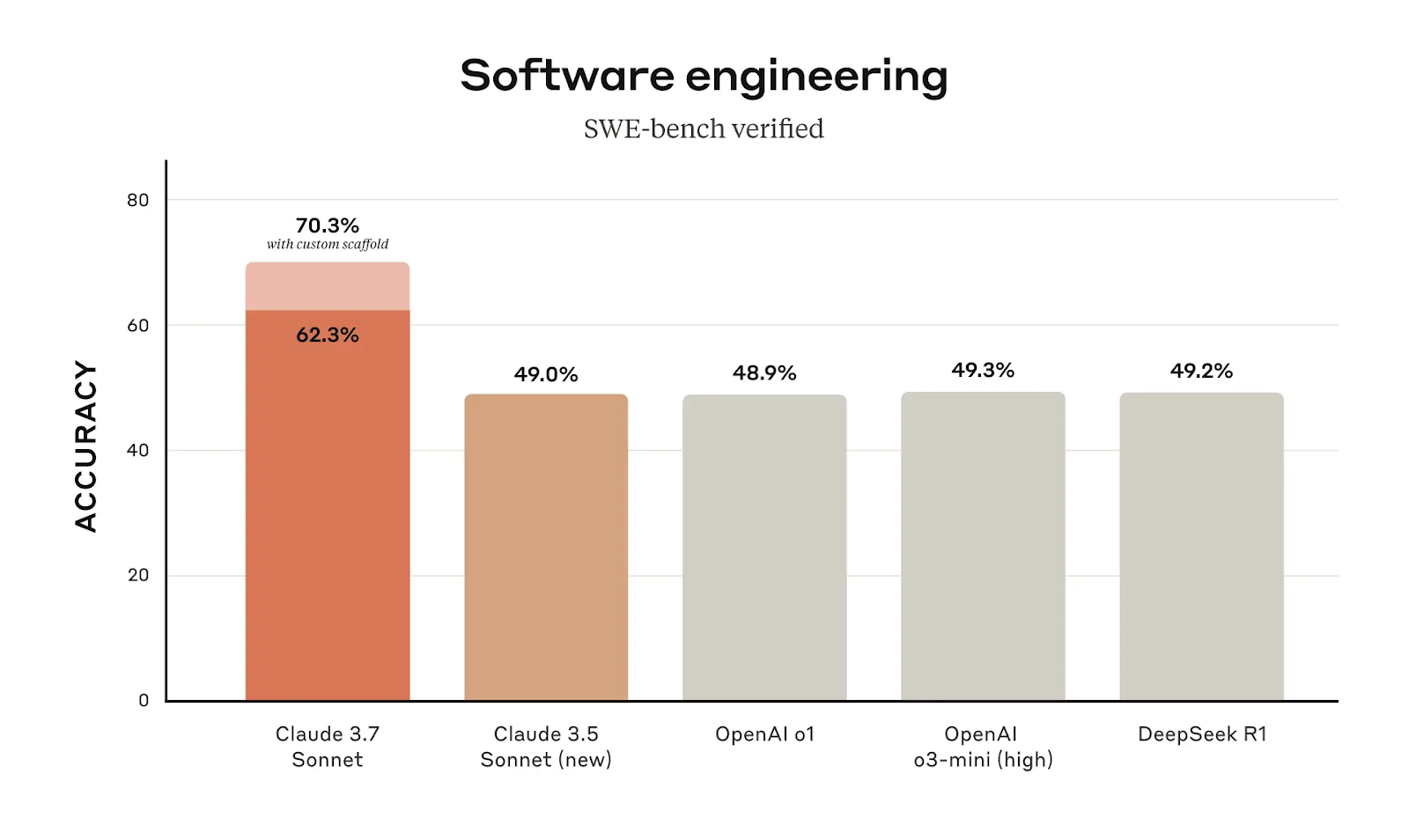
Source: Anthropic
A nearly 13% improvement in accuracy between model versions is not just a small refinement. It suggests that Claude 3.7 Sonnet has been optimized for better understanding and execution of programming-related tasks. For users who rely on Claude for software engineering, debugging, or automation, the upgrade makes a tangible difference.
Agentic tool use
Performance in agentic tool use is another area where Claude 3.7 Sonnet surpasses its predecessor. In retail-related tasks, it achieves 81.2% accuracy, up from Claude 3.5 Sonnet’s 71.5%. In airline-related tasks, it scores 58.4%, an almost ten-point improvement over the previous version.
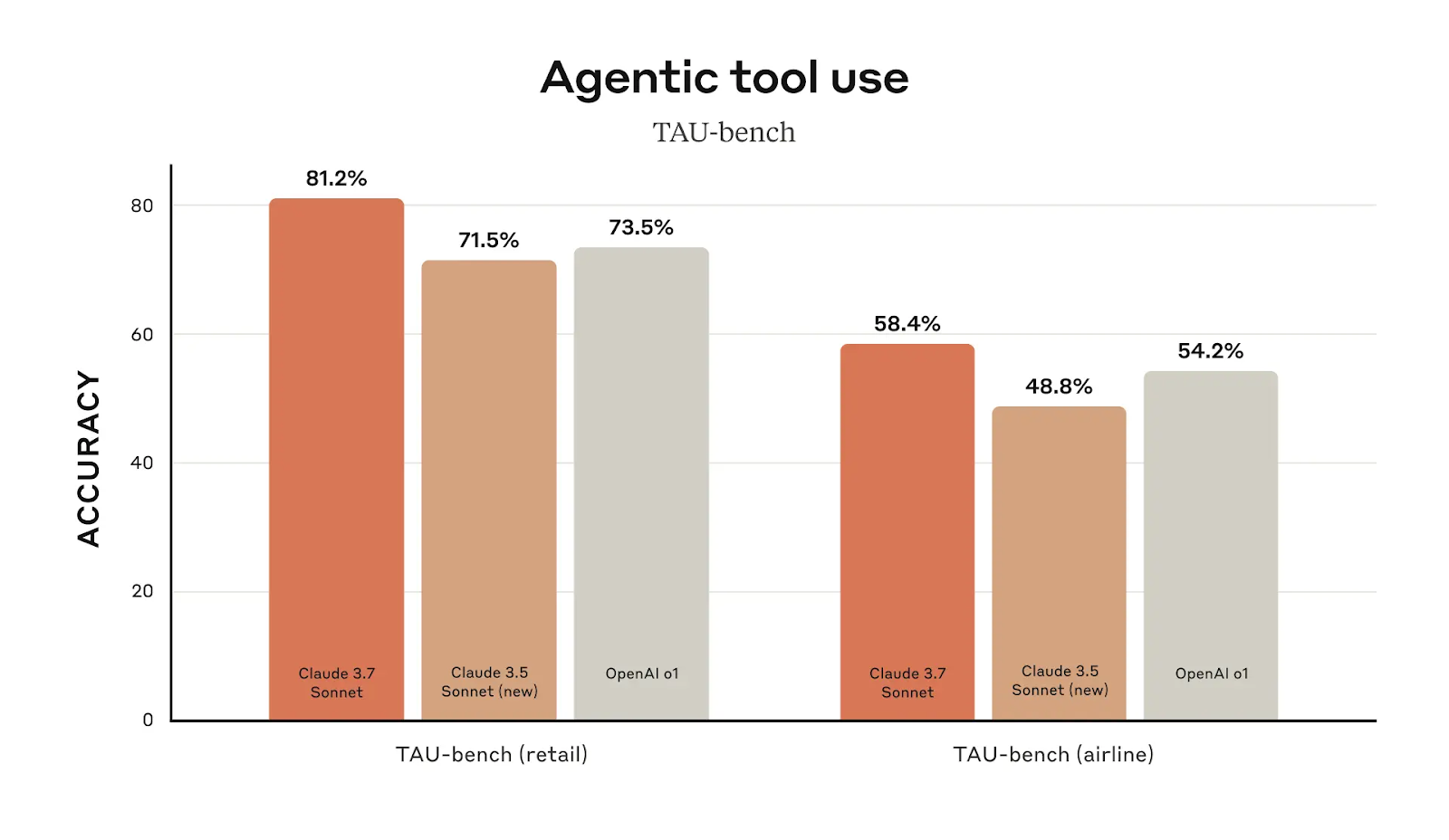
Source: Anthropic
Overall benchmarks
Across all benchmarks, the largest gains come from extended thinking mode, which allows Claude 3.7 to perform at a much higher level in complex reasoning tasks. Users who rely on AI for structured workflows, coding, or problem-solving will see a clear difference between Claude 3.5 and Claude 3.7, especially when using extended thinking.
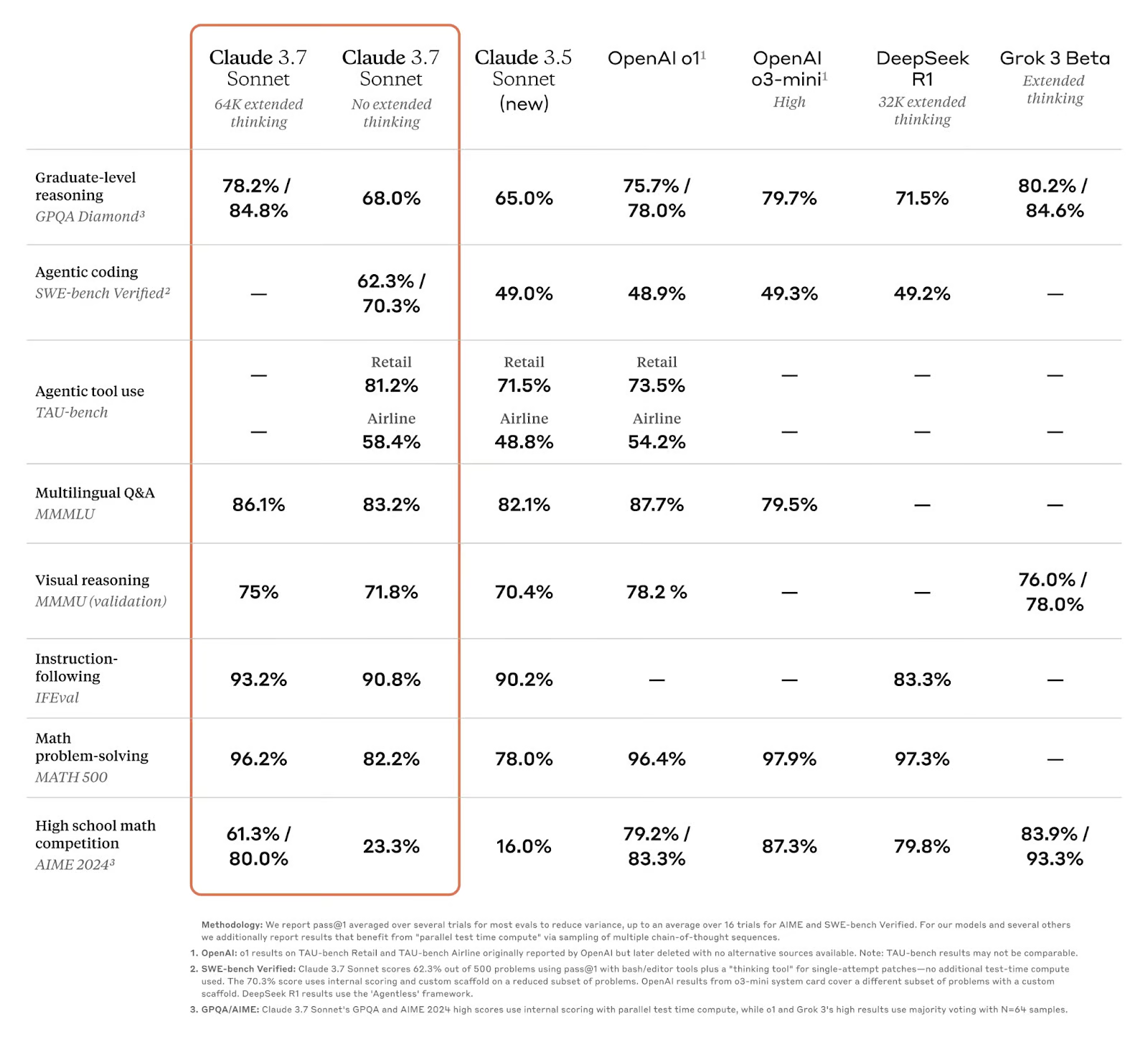
Source: Anthropic
Most of this progress comes from Claude’s extended thinking, so let’s find out more about this.
Claude’s Extended Thinking
When enabled, extended thinking mode increases the number of reasoning steps Claude takes before finalizing an answer. Developers can fine-tune this process by setting a thinking budget, which defines how many tokens the model can use while working through a problem. As shown in the AIME 2024 performance graph below, accuracy improves as more tokens are allocated, following a logarithmic trend.
Source: Anthropic
This approach mirrors human cognitive effort: for simple tasks, quick answers suffice, but for complex ones, deeper analysis leads to better results. Claude can now decide when to pause, re-evaluate, and refine its reasoning rather than defaulting to immediate responses.
One of the most interesting aspects of extended thinking mode is that Claude’s reasoning process is visible to the user. However, this feature raises some challenges. While it provides insight into AI reasoning, the displayed thought process might not always perfectly align with how the model actually makes decisions. The “faithfulness problem”—whether an AI’s self-reported thoughts accurately represent its internal mechanics—is still an open research question.
Claude 3.7 Sonnet’s ability to engage in long-term, iterative reasoning is tested in evaluations like OSWorld and Pokémon Red gameplay. In Pokémon Red, for instance, Claude 3.7 Sonnet achieves far greater in-game progression than previous versions, making it through multiple milestones while earlier models get stuck early in the game.
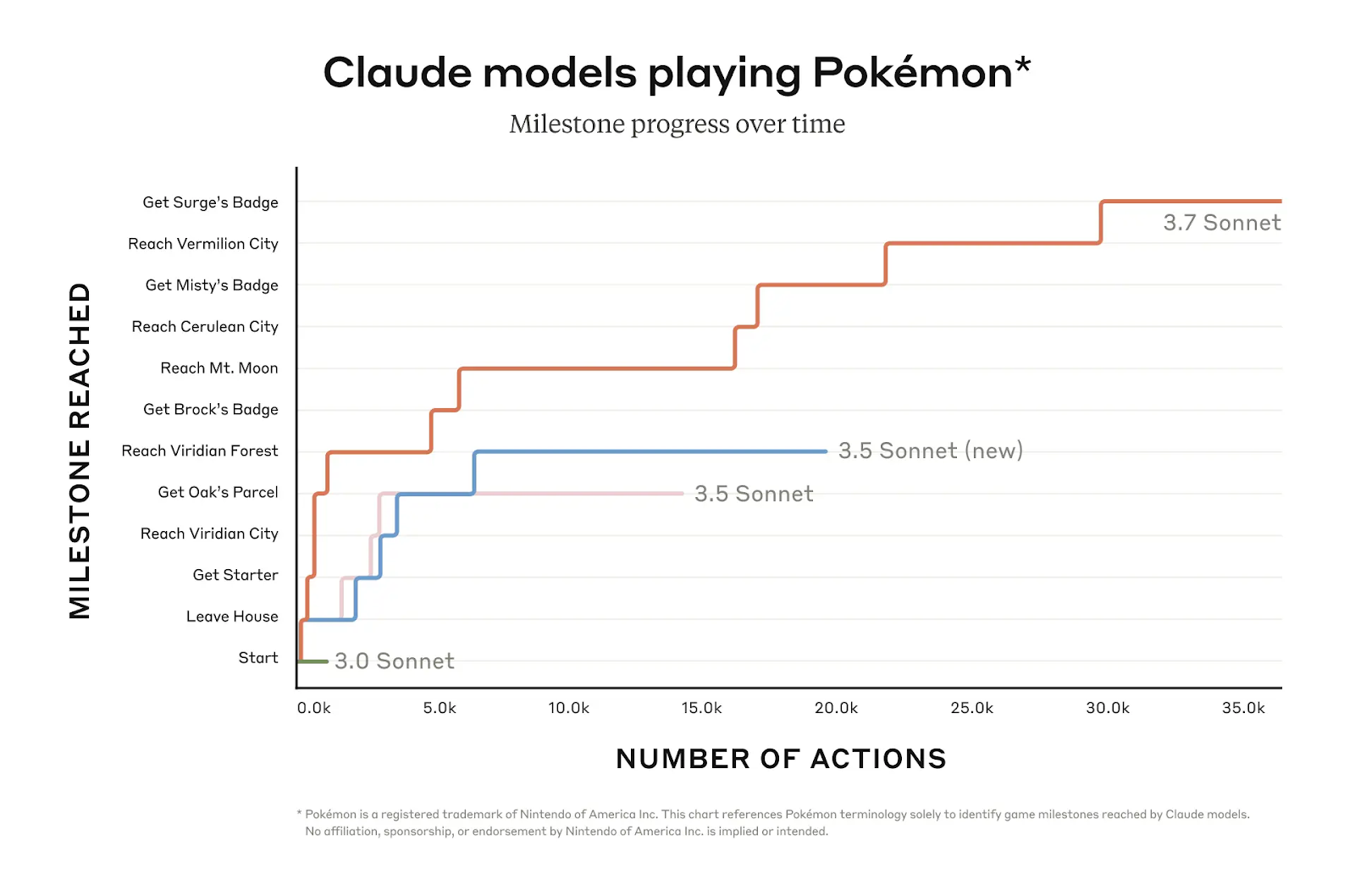
Source: Anthropic
Claude 3.7 Sonnet Benchmarks
We’ve seen how Claude 3.7 Sonnet performs against its earlier version, but how does it compare to OpenAI’s o3-mini, DeepSeek-R1, or Grok 3?
Looking at the updated benchmarks, Claude 3.7 Sonnet has positioned itself as one of the top-performing models, especially in reasoning-heavy tasks, coding, and agentic tool use.
Reasoning and math
In graduate-level reasoning (GPQA Diamond), Claude 3.7 Sonnet scores 68.0% in standard mode and 84.8% in extended thinking mode, making it one of the strongest models in this category. It outperforms OpenAI’s o1 (78.0%) and DeepSeek-R1 (71.5%) by a significant amount and Grok 3 Beta (84.6%) by only a small margin.
|
Benchmark |
Claude 3.7 Sonnet (Standard) |
Claude 3.7 Sonnet (Extended Thinking) |
OpenAI o1 |
OpenAI o3-mini (high) |
DeepSeek R1 |
Grok 3 Beta |
|
GPQA Diamond (Graduate-level reasoning) |
68.0% |
84.8% |
78.0% |
79.7% |
71.5% |
84.6% |
|
AIME 2024 (High school math competition) |
23.3% |
80.0% |
83.3% |
87.3% |
79.8% |
93.3% |
|
Math Problem-Solving (MATH 500) |
82.2% |
96.2% |
96.4% |
97.9% |
97.3% |
- |
The AIME 2024 benchmark, which tests high school math competition problems, shows a similar trend. Claude 3.7 Sonnet makes a huge leap from previous versions, scoring 80.0% with extended thinking enabled. While it beats DeepSeek-R1 (79.8%) by a small margin, it still lags behind OpenAI’s o3-mini (87.3%) and Grok 3 Beta (93.3%).
In math problem-solving (MATH 500), Claude 3.7 Sonnet achieves 96.2%, closely matching OpenAI’s o3-mini (97.9%) and DeepSeek R1 (97.3%).
Coding and agentic tool use
Claude 3.7 Sonnet makes its biggest gains in coding benchmarks. On SWE-bench Verified (which evaluates AI models on software engineering tasks), Claude 3.7 Sonnet scores 62.3%, rising to 70.3% with a custom scaffold. This puts it far ahead of OpenAI’s o1 (48.9%) and o3-mini (49.3%), as well as DeepSeek R1 (49.2%), which was designed with coding in mind. This confirms that Claude 3.7 is now one of the best AI models for programming-related tasks.
|
Benchmark |
Claude 3.7 Sonnet (Standard) |
Claude 3.7 Sonnet (Custom Scaffold) |
OpenAI o1 |
OpenAI o3-mini (high) |
DeepSeek R1 |
|
SWE-bench Verified (Coding) |
62.3% |
70.3% |
48.9% |
49.3% |
49.2% |
|
TAU-bench Retail (Tool Use) |
81.2% |
- |
73.5% |
- |
- |
|
TAU-bench Airline (Tool Use) |
58.4% |
- |
54.2% |
- |
- |
Beyond coding, Claude 3.7 Sonnet leads in agentic tool use, making it a strong choice for automation and workflow execution. On TAU-bench (which tests AI’s ability to interact with external tools in structured environments), Claude 3.7 scores 81.2% in retail-related tasks, surpassing OpenAI o1 (73.5%). In airline-related tasks, Claude 3.7 reaches 58.4%, again outperforming OpenAI o1 (54.2%).
This suggests that Claude 3.7 is well-suited for business applications and structured workflows, making it a strong choice for enterprise users looking to integrate AI into their decision-making and operational processes.
How to Access Claude 3.7 Sonnet
Claude 3.7 Sonnet is available through multiple channels, including Anthropic’s web interface, Claude’s integration in various apps, and API access for developers. While the model is a significant upgrade, its availability comes with some limitations—especially if you want to use Thinking Mode, which is currently locked behind a paid tier.
Web and app access
For general users, Claude 3.7 Sonnet is accessible through Anthropic’s official website (claude.ai) and the Claude app. It is available in the free tier, but with restrictions:
- Free users can access Claude 3.7 Sonnet for basic tasks like writing, summarization, and general Q&A, but Thinking Mode is disabled.
- Claude Pro users (the $20/month paid plan) get full access to Thinking Mode, along with higher message limits and priority access during peak usage times.
To enable Thinking Mode, you need to click on Extended from the model dropdown menu:
Claude 3.7 Sonnet API access
Developers can integrate Claude 3.7 Sonnet into their applications using Anthropic’s API, which is accessible via Anthropic’s developer portal. The API supports a pay-as-you-go pricing model based on token usage.
Here’s an overview of Anthropic’s API offerings:
|
Feature |
Claude 3.7 Sonnet |
Claude 3.5 Sonnet |
Claude 3.5 Haiku |
Claude 3 Opus |
Claude 3 Haiku |
|
Description |
Our most intelligent model |
Our previous most intelligent model |
Our fastest model |
Powerful model for complex tasks |
Fastest and most compact model for near-instant responsiveness |
|
Strengths |
Highest level of intelligence and capability with toggleable extended thinking |
High level of intelligence and capability |
Intelligence at blazing speeds |
Top-level intelligence, fluency, and understanding |
Quick and accurate targeted performance |
|
Multilingual |
Yes |
Yes |
Yes |
Yes |
Yes |
|
Vision |
Yes |
Yes |
Yes |
Yes |
Yes |
|
Yes |
No |
No |
No |
No |
|
|
API model name |
claude-3-7-sonnet-20250219 |
Upgraded version: claude-3-5-sonnet-20241022 Previous version: claude-3-5-sonnet-20240620 |
claude-3-5-haiku-20241022 |
claude-3-opus-20240229 |
claude-3-haiku-20240307 |
|
Comparative latency |
Fast |
Fast |
Fastest |
Moderately fast |
Fastest |
|
Context window |
200K |
200K |
200K |
200K |
200K |
|
Max output |
Normal: 8192 tokens Extended thinking:64000 tokens |
8192 tokens |
8192 tokens |
4096 tokens |
4096 tokens |
|
Cost (Input / Output per MTok) |
$3.00 / $15.00 |
$3.00 / $15.00 |
$0.80 / $4.00 |
$15.00 / $75.00 |
$0.25 / $1.25 |
|
Training data cut-off |
Oct 2024 |
Apr 2024 |
July 2024 |
Aug 2023 |
Aug 2023 |
Source: Anthropic
Make sure to always check the latest API pricing.
Conclusion
Anthropic just made its biggest move in a while with Claude 3.7 Sonnet, a model that finally brings it into the reasoning AI space. Based on the benchmarks, we can see that it’s a legitimate competitor to OpenAI’s o3-mini, DeepSeek-R1, and Grok 3, with strong performance in coding, structured problem-solving, and agentic tool use.
The ability to switch between generalist and reasoning modes makes it more versatile, but locking Thinking Mode behind a paywall feels like a misstep, especially with free alternatives available. Still, Claude 3.7 is a major step forward.
Are you ready for the next step? Tune in to our Claude 3.7 Sonnet API video where we will show you how you can build your very own multimodal research assistant.
I’m an editor and writer covering AI blogs, tutorials, and news, ensuring everything fits a strong content strategy and SEO best practices. I’ve written data science courses on Python, statistics, probability, and data visualization. I’ve also published an award-winning novel and spend my free time on screenwriting and film directing.

I'm a data science writer and editor with contributions to research articles in scientific journals. I'm especially interested in linear algebra, statistics, R, and the like. I also play a fair amount of chess!
FAQs
What is Claude Code, and how does it compare to Claude 3.7 Sonnet?
Claude Code is a separate model optimized for software development, distinct from Claude 3.7 Sonnet. While Claude 3.7 is a general-purpose LLM with strong coding abilities, Claude Code is fine-tuned specifically for programming tasks, debugging, and agentic tool use.
How does Claude 3.7 Sonnet handle longer context compared to previous models?
Claude 3.7 Sonnet retains a 200K token context window, but extended thinking allows it to reason more effectively over long documents. While other models (like Gemini 2.0) advertise longer context capabilities, Anthropic emphasizes structured reasoning over raw memory length.
Does Claude 3.7 Sonnet support multimodal input?
Yes, Claude 3.7 Sonnet includes multimodal capabilities, meaning it can process and analyze images.
What safety improvements have been made in Claude 3.7 Sonnet?
Anthropic has expanded alignment stress testing and refined constitutional AI principles, ensuring better safeguards against bias, misinformation, and misuse. However, jailbreaking attempts are still an area of concern, as visible thinking mode could expose vulnerabilities.
Is there a Claude mobile app?
Yes, you can access Claude on both iOS and Android.



